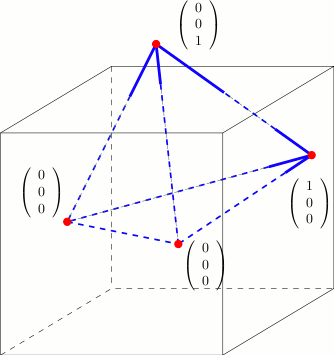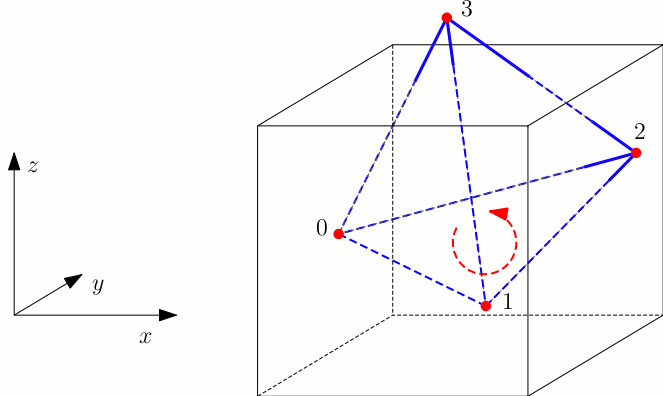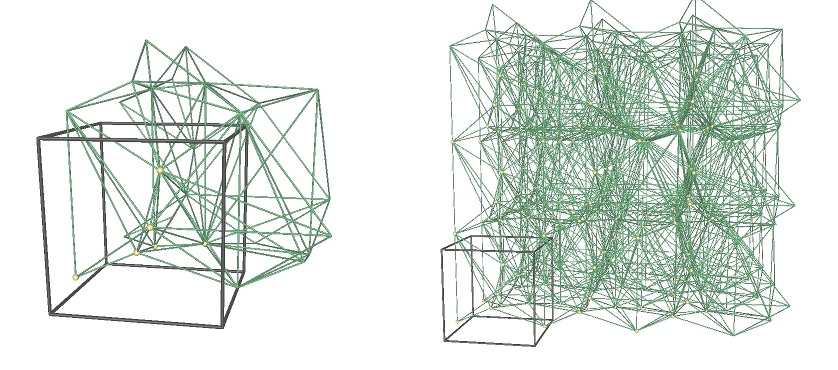|
CGAL 5.5.1 - 3D Periodic Triangulations
|
|
CGAL 5.5.1 - 3D Periodic Triangulations
|

The periodic 3D-triangulation class of CGAL is designed to represent the triangulations of a set of points in the three-dimensional flat torus. The triangulation forms a partition of the space it is computed in. It is a simplicial complex, i.e. it contains all incident \( j\)-simplices ( \( j<k\)) of any \( k\)-simplex and two \( k\)-simplices either do not intersect or share a common \( j\)-face, \( j<k\). The occurring simplices of dimension up to three are called vertex, edge, facet, and cell, respectively.
The 3D Periodic Triangulation package computes triangulations in the space \( \mathbb T_c^3\), which is defined as follows: Let \( c\in\mathbb R\setminus\{0\}\) and \( G\) be the group \( (c\cdot\mathbb Z^3, +)\), where \( c\cdot\mathbb Z\) denotes the set containing all integer multiples of \( c\). The flat torus is the quotient space: \( \mathbb T_c^3:=\mathbb R^3/G\). The parameter \( c\) defines the period.
The elements of \( \mathbb T_c^3\) are the equivalence classes of sets of points in \( \mathbb R^3\). We call these points representatives of an element of \( \mathbb T_c^3\). The implementation works not directly on elements of \( \mathbb T_c^3\) but on some representatives in \( \mathbb R^3\). So there need to be distinguished representatives to work on. Given \( \alpha\), \( \beta\), and \( \gamma\), the cube \( [\alpha,\alpha+c)\times[\beta,\beta+c)\times[\gamma,\gamma+c)\) contains exactly one representative of each element in \( \mathbb T_c^3\). We call it original domain. From now on, when we talk about points, we generally mean representatives of elements of \( \mathbb T_c^3\) that lie inside the original domain. Note that any input point is required to be an element of the half-open cube representing the original domain as defined above.
There are simplices containing points inside the original domain but also points outside it. The points outside the original domain are periodic copies of points inside the original domain. So, to specify a simplex we need points together with some additional information that determines the respective periodic copy of each point. The set of representatives of an element of \( \mathbb T_c^3\) is a cubic point grid. We address each representative by a three-dimensional integer vector \( (o_x,o_y,o_z)\), called offset. It represents the number of periods a representative in the original domain must be translated in \( x\)-, \( y\)-, and \( z\)-direction. The vector \( (0,0,0)\) corresponds to the representative in the original domain. To specify a \( k\)-simplex we need \( k+1\) point-offset pairs (cf. Figure 47.1).

A triangulation is a collection of vertices and cells that are linked together through incidence and adjacency relations. Each cell gives access to its four incident vertices, their corresponding offsets, and to its four adjacent cells. Each vertex gives access to one of its incident cells.
The four vertices of a cell are indexed with 0, 1, 2 and 3 in positive orientation. The orientation of a simplex in \( \mathbb T_c^3\) is defined as the orientation of the corresponding simplex in \( \mathbb R^3\) given by representatives determined by the respective offsets (see Figure 47.2).

As in the underlying combinatorial triangulation (see Chapter 3D Triangulation Data Structure), the neighbors of a cell are indexed with 0, 1, 2, 3 in such a way that the neighbor indexed by \( i\) is opposite to the vertex with the same index. Also edges ( \( 1\)-faces) and facets ( \( 2\)-faces) are not explicitly represented: a facet is given by a cell and an index (the facet i of a cell c is the facet of c that is opposite to the vertex with index i) and an edge is given by a cell and two indices (the edge (i,j) of a cell c is the edge whose endpoints are the vertices of c with indices i and j). See Figure 46.1 of chapter 3D Triangulation Data Structure.
Some point sets do not admit a triangulation in \( \mathbb T_c^3\). In this case we use 27 periodic copies of the point set arranged in a cube of edge length \( 3c\). Any point set constructed in this way has a triangulation in \( \mathbb R^3/G'\) with \( G'=((3c\cdot\mathbb Z)^3,+)\) [1]. So we compute the triangulation in this space, which is a 27-sheeted covering space of \( \mathbb T_c^3\) (see Figure 47.3).

The machinery that manages the copies is largely hidden from the user. However there are some effects that cannot be ignored. For example if the point set does not permit a triangulation in \( \mathbb T_c^3\) then the combinatorial iterators (Cell_iterator, Facet_iterator, Edge_iterator, and Vertex_iterator) return all simplices that are internally stored, which correspond to 27 periodic copies of each geometric primitive (Tetrahedron, Triangle, Segment, and Point). This is necessary to ensure consistency in the adjacency relations. In case it is desired to have only one periodic copy of each primitive, we provide geometric iterators. They return geometric primitives of the triangulation without relations between them. Another effect is that when the algorithm switches from the 27-sheeted covering space to the 1-sheeted covering space, the Vertex_handles and Cell_handles referencing deleted items become invalid.
In the data structure each vertex stores the input point it corresponds to. If we are computing in the 27-sheeted covering space, each vertex stores the representative inside the original domain it corresponds to. So, the 27 vertices corresponding to the same element of \( \mathbb T_c^3\) all store the same representative in \( \mathbb R^3\), and not different periodic copies.
Validity
A periodic triangulation is said to be locally valid iff
(a)-(b) Its underlying combinatorial graph, the triangulation data structure, is locally valid (see Section Representation of Chapter 3D Triangulation Data Structure)
(c) Any cell has its vertices ordered according to positive orientation. See Figure 47.2.
The class Periodic_3_Delaunay_triangulation_3 implements Delaunay triangulations of point sets in \( \mathbb T_c^3\).
Delaunay triangulations have the empty sphere property, that is, the circumscribing sphere of each cell does not contain any other vertex of the triangulation in its interior. These triangulations are uniquely defined except in degenerate cases where five points are co-spherical. Note however that the CGAL implementation computes a uniquely defined triangulation even in these cases [2].
This implementation is fully dynamic: it supports both point insertion and vertex removal.
The class Periodic_3_regular_triangulation_3 implements regular triangulations, also known as weighted Delaunay triangulations, of point sets in \( \mathbb T_c^3\).
A regular triangulation is a triangulation in which the power sphere of each simplex is regular. See Section Regular Triangulation for a complete definition. As for Delaunay triangulations, CGAL computes a uniquely defined regular triangulation even in degenerate cases [3].
The implementation is fully dynamic: it supports both point insertion and vertex removal.
The class Periodic_3_triangulation_hierarchy_3 is the adaptation of the hierarchical structure described in chapter 3D Triangulations to the periodic case.
We have chosen the prefix "Periodic_3" to emphasize that the triangulation is periodic in all three directions of space.
The main classes Periodic_3_triangulation_3, Periodic_3_Delaunay_triangulation_3, and Periodic_3_regular_triangulation_3 provide high-level geometric functionality and are responsible for the geometric validity. They are built as layers on top of a triangulation data structure, which stores their combinatorial structure. This separation between the geometry and the combinatorics is reflected in the software design by the fact that the triangulation classes take two template parameters:
The class Periodic_3_triangulation_3 contains all the functionality that is common to triangulations in general, such as location of a point in the triangulation [4], access functions, geometric queries like the orientation test etc. The class Periodic_3_Delaunay_triangulation_3 contains all the functionality that is specific to Delaunay triangulations, such as point insertion and vertex removal, the side-of-sphere test, finding the conflicting region of a given point, computation of dual functions, etc. The class Periodic_3_regular_triangulation_3 does the same for regular triangulations.
The first template parameter of the triangulation class Periodic_3_triangulation_3<Periodic_3TriangulationTraits_3, TriangulationDataStructure_3> is the geometric traits class, described by the concept Periodic_3TriangulationTraits_3. It is different to the TriangulationTraits_3 (see chapter 3D Triangulations) in that it implements all objects, predicates and constructions using offsets.
The class CGAL::Periodic_3_triangulation_traits_3<TriangulationTraits_3,Periodic_3Offset_3> provides the required functionality. It expects two template parameters: a model of the concept TriangulationTraits_3 and a model of the concept Periodic_3Offset_3.
The second parameter Periodic_3Offset_3 defaults to CGAL::Periodic_3_offset_3.
The first template parameter of the Delaunay triangulation class Periodic_3_Delaunay_triangulation_3<Periodic_3DelaunayTriangulationTraits_3, TriangulationDataStructure_3> is the geometric traits class, described by the concept Periodic_3DelaunayTriangulationTraits_3. It is different to the DelaunayTriangulationTraits_3 (see chapter 3D Triangulations) in that it implements all objects, predicates and constructions using offsets.
The class Periodic_3_Delaunay_triangulation_traits_3<DelaunayTriangulationTraits_3,Periodic_3Offset_3> provides the required functionality. It expects two template parameters: a model of the concept DelaunayTriangulationTraits_3 and a model of the concept Periodic_3Offset_3.
The second parameter Periodic_3Offset_3 defaults to CGAL::Periodic_3_offset_3.
The first template parameter of the regular triangulation class Periodic_3_regular_triangulation_3<Periodic_3RegularTriangulationTraits_3, TriangulationDataStructure_3> is the geometric traits class, described by the concept Periodic_3RegularTriangulationTraits_3. It is different to the RegularTriangulationTraits_3 (see chapter 3D Triangulations) in that it implements all objects, predicates and constructions using offsets.
The class Periodic_3_regular_triangulation_traits_3<RegularTriangulationTraits_3,Periodic_3Offset_3> provides the required functionality. It expects two template parameters: a model of the concept RegularTriangulationTraits_3 and a model of the concept Periodic_3Offset_3.
The second parameter Periodic_3Offset_3 defaults to Periodic_3_offset_3.
The kernels Cartesian, Homogeneous, Simple_cartesian, Simple_homogeneous and Filtered_kernel can all be used as models of the concepts TriangulationTraits_3, DelaunayTriangulationTraits_3, and RegularTriangulationTraits_3. The periodic triangulation classes provide exact predicates and exact constructions if these respective template parameters do. They provide exact predicates but not exact constructions if Filtered_kernel<CK> with CK an inexact kernel is used as template parameter. Using Exact_predicates_inexact_constructions_kernel provides fast and exact predicates and not exact constructions, using Exact_predicates_exact_constructions_kernel provides fast and exact predicates and exact constructions. The latter is recommended if the dual constructions and constructions of points, segments, triangles, and tetrahedra are used.
The second template parameter of the periodic triangulation classes is a triangulation data structure class. This parameter must meet the requirements described in the concept TriangulationDataStructure_3, for which CGAL offers the model CGAL::Triangulation_data_structure_3. To represent periodic triangulations, the face and vertex of the triangulation data structure must be also be models of extended concepts. The model CGAL::Triangulation_data_structure_3 is parameterized by a vertex base class and a face base class, which gives the possibility to customize the vertices and faces used by the triangulation data structure.
A default value for the triangulation data structure parameter is provided in all the triangulation classes, so it does not need to be specified by the user unless he wants to use a different triangulation data structure or a different vertex or cell base class.
The class Periodic_3_triangulation_3 uses the TriangulationDataStructure_3 in essentially the same way as the class Triangulation_3 and the flexibility described in Software Design is therefore applicable in exactly the same way. Furthermore, the classes Triangulation_vertex_base_with_info_3 and Triangulation_cell_base_with_info_3 can be reused directly, see Example Adding a Color.
This example shows the incremental construction of a 3D Delaunay triangulation, the location of a point and how to perform elementary operations on indices in a cell. It uses the default parameter of the class Periodic_3_Delaunay_triangulation_3 for the triangulation data structure.
File Periodic_3_triangulation_3/simple_example.cpp
The following two examples show how the user can plug his own vertex base in a triangulation. Changing the cell base is similar.
If the user does not need to add a type in a vertex that depends on the TriangulationDataStructure_3 (e.g. a Vertex_handle or Cell_handle), then he can use the Triangulation_vertex_base_with_info_3 class to add his own information easily in the vertices. The example below shows how to add a Color this way.
File Periodic_3_triangulation_3/colored_vertices.cpp
If the user needs to add a type in a vertex that depends on the TriangulationDataStructure_3 (e.g. a Vertex_handle or Cell_handle), then he has to derive his own vertex base class, as the following example shows.
File Periodic_3_triangulation_3/periodic_adding_handles.cpp
The user can check at any time whether a triangulation would be a simplicial complex in \( \mathbb T_c^3\) and force a conversion if so. However, this should be done very carefully in order to ensure that the internal structure always remains a simplicial complex and thus a triangulation.
In this example, we construct a triangulation that can be converted to the 1-sheeted covering space. However, we can insert new points such that the point set does not have a Delaunay triangulation in the 1-sheeted covering space anymore, rendering the triangulation not extensible.
File Periodic_3_triangulation_3/covering.cpp
Two optimizations are available for large point sets. Firstly, spatial sorting can be used to sort the input points according to a Hilbert curve, see chapter Spatial Sorting. Secondly, 36 appropriately chosen dummy points can be inserted to avoid the use of a 27-sheeted covering space in the beginning. These 36 dummy points are deleted in the end. If the point set turns out to not have a Delaunay triangulation in the 1-sheeted covering space, the triangulation is converted to the 27-sheeted covering space during the removal of the 36 dummy points. Note that this might take even longer than computing the triangulation without using this optimization. In general, uniformly distributed random point sets of more than 1000 points have a Delaunay triangulation in the 1-sheeted covering space.
The following example illustrates the use of these optimization techniques.
File Periodic_3_triangulation_3/large_point_set.cpp
Some application might use the geometric primitives of a triangulation as an input but not require a simplicial complex. We provide for these cases the geometric iterators that return only the geometric primitives fulfilling some properties. In the following example, we use the Periodic_3_triangulation_3::Periodic_triangle_iterator with the option UNIQUE_COVER_DOMAIN. This means that only the triangles that have a non-empty intersection with the original domain of the 1-sheeted covering space are returned, see Figure P3Triangulation3figgeom_iterators. The Periodic_3_triangulation_3::Periodic_triangle is actually a three-dimensional array of point-offset pairs. We check for all three entries of the periodic triangle whether the offset is (0,0,0) using the method is_null. If so, we convert the periodic triangle to a PK::Triangle_3, which requires exact constructions to be exact.
File Periodic_3_triangulation_3/geometric_access.cpp
The following five examples illustrate various features of 3D periodic regular triangulations.
This example shows the incremental construction of a 3D Delaunay triangulation, the location of a point and how to perform elementary operations on indices in a cell. It uses the default parameter of the class Periodic_3_regular_triangulation_3 for the triangulation data structure.
File Periodic_3_triangulation_3/simple_regular_example.cpp
This example shows the incremental construction of a 3D regular triangulation, and the removal of a vertex. It uses the default parameter of the Periodic_3_regular_triangulation_3 class for the triangulation data structure.
File Periodic_3_triangulation_3/p3rt3_insert_remove.cpp
This example shows the incremental construction of a 3D regular triangulation. It uses a more appropriate triangulation data structure, which saves some memory resources.
File Periodic_3_triangulation_3/p3rt3_insert_only.cpp
This example shows that points can be hidden during the incremental construction of a 3D regular triangulation.
File Periodic_3_triangulation_3/p3rt3_hidden_points.cpp
Finally, this example shows how points whose weight does not satisfy the precondition are handled during the incremental construction of a 3D regular triangulation.
File Periodic_3_triangulation_3/p3rt3_insert_point_with_bad_weight.cpp
It is possible to use the classes Periodic_3_Delaunay_triangulation_3 and Periodic_3_regular_triangulation_3 as underlying triangulations to compute alpha shapes. Examples of usage can be found in Section Example for Periodic Alpha Shapes of the chapter on 3D alpha shapes.
In 2006, Nico Kruithof started to work with Monique Teillaud on the 3D Periodic Triangulations package.
In 2007, Manuel Caroli continued work on the algorithms [1] and on the package with Monique Teillaud.
In 2015, Aymeric Pellé contributed to adding regular triangulations in the package.
The package follows the design of the 3D Triangulations package (see Chapter 3D Triangulations).